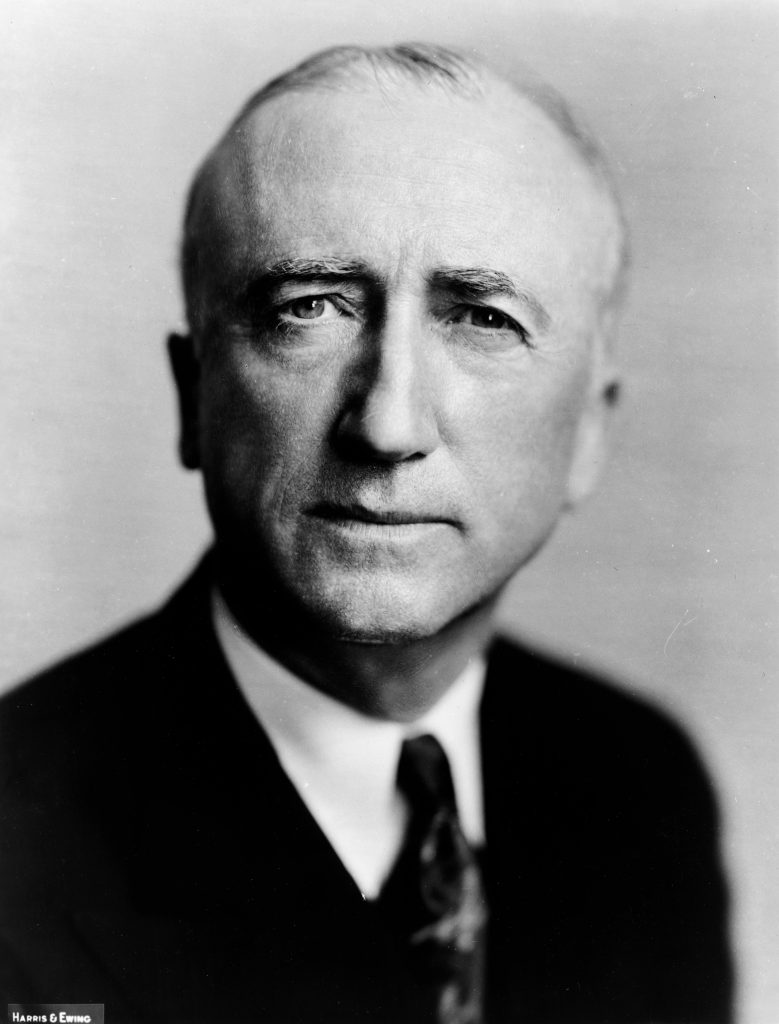James F. Byrnes (1882-1972) was U.S. Secretary of State from 1945-1947 under President Truman.
EARLY YEARS
“Jimmy” Byrnes was born in Charleston, South Carolina. He left school at the age of fourteen to work as a clerk at a law firm. In 1900, when his cousin, Governor Miles B. McSweeney, appointed him to clerk for Judge Robert Aldrich of Aiken, he changed the year of his birth from 1882 to 1879 to meet the age requirement of 21 years. While working in this position, he apprenticed to a number of lawyers and judges. In 1903, at the actual age of 21 and without having gone to law school, he was admitted to the bar as a self-taught lawyer.
Byrnes had an impressive career in public service. Over the course of his life, he served in all three branches of the federal government and remained engaged in state politics. From 1911-1925 he served six terms as a US Representative for South Carolina’s Third Congressional District. In 1924, he ran for Senate against the incumbent, lost the race, and resumed practicing law.
In 1930, the relentless Byrnes decided to run for Senate once again. This time, he campaigned on a platform that sought to introduce new economic reforms in the midst of the Great Depression. Byrnes won by a slim margin and served as a senator from 1931-1941. During this time, he became a dedicated and loyal supporter and ally of President Franklin D. Roosevelt and championed his New Deal policies in the Senate.
President Roosevelt appointed Byrnes as a US Supreme Court justice on June 12, 1941. The Senate confirmed his appointment the same day. Byrnes served on the bench for sixteen months between 1941 and 1942. He was the last justice on the Supreme Court admitted by reading law as opposed to studying it at law school.
WORLD WAR II AND THE MANHATTAN PROJECT
Following Pearl Harbor and the outbreak of WWII, Byrnes desired to return to politics. He resigned from the Supreme Court on October 3, 1942 and became the head of the wartime Office of Economic Stabilization in Washington, D.C. In this capacity, Byrnes was responsible for developing a comprehensive economic plan to finance the war, which included new taxes, rationing, price controls, the distribution of material resources, and organization of war industry and production.
In May 1943 he became the director of FDR’s newly created Office of War Mobilization in which he oversaw industrial mobilization. Under his leadership, the US was able to construct new factories to increase production and reduce unemployment; military-civilian contractors also increasingly collaborated with one another.
Byrnes also helped oversee the Manhattan Project and met regularly with top scientists on the project to coordinate nuclear policy during the war. He additionally ensured that the project had access to the necessary material and financial resources and ensured it continued to receive top priority.
Arthur Herman, author of Freedom’s Forge: How American Business Produced Victory in World War II, observed “As the head of the new War Mobilization Board, he had so many sweeping powers, some called him ‘Assistant President.’”
In the 1944 election, Byrnes had hoped to be FDR’s vice presidential nominee. However, worried that his conservatism could hurt them in the election, Democratic National Convention delegates instead selected U.S. Senator Harry S. Truman.
In February 1945, Byrnes accompanied President Roosevelt to the Yalta Conference. This experience interacting with Soviet leaders later proved invaluable to President Truman after FDR’s death on April 12, 1945.
Byrnes remained a close and trusted advisor to the new president, his former Senate colleague. On July 3, 1945, President Truman appointed Byrnes as his Secretary of State. He was unanimously confirmed by the Senate.
DECISION TO DROP THE BOMB
In May 1945, Secretary of War Henry L. Stimson established the secret Interim Committee to advise the President and offer recommendations on the use of the bomb. He selected Byrnes as Truman’s personal representative. For Byrnes the decision to use the bomb on Japan had political implications beyond ending the war. Byrnes believed in “atomic diplomacy,” whereby the US could leverage the bomb in post-war negotiations and make Russia “more manageable.”
Ultimately, at a June 1, 1945 Interim Committee meeting, Byrnes recommended the use of the atomic bomb. Martin Sherwin writes in A World Destroyed: Hiroshima and the Origins if the Arms Race, “Byrnes suggested, and the members of the Interim Committee agreed, that the Secretary of War should be advised ‘the present view of the Committee was that the bomb should be used against Japan as soon as possible; that it be used on a war plant surrounded by workers’ homes without prior warning.’”
For Byrnes, the decision to use the bomb not only promised to end the war sooner but also in his words “might put us in a position to dictate our own terms at the end of the war.”
LATER YEARS
Resigning from his position as Secretary of State on January 21, 1947, Byrnes returned to practicing law. He was named TIME magazine’s Man of the Year in 1947 and appeared on the cover of the January 6th issue. Later, Byrnes became Governor of South Carolina in 1951 and served one term in this position before retiring in 1955.
Byrnes died on April 9, 1972 at the age of 90 in Columbia, South Carolina.





